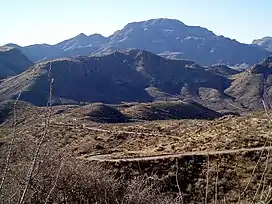Chinati Mountains
The Chinati Mountains of Texas are a small range in the high desert of far West Texas near the city of Presidio. There is a pass through the mountains on Ranch to Market Road 2810, also known as Pinto Canyon Road, which connects to Farm to Market Road 170 at Ruidosa, Texas. Some believe the range derives its name from the Apache word ch'íná'itíh, which means gate or mountain pass.
| Chinati Mountains | |
|---|---|
 Pinto Canyon Road in the Chinati Mountains | |
| Highest point | |
| Peak | Chinati Peak |
| Elevation | 7,728 ft (2,355 m) |
| Coordinates | 29°54′N 104°28′W |
| Geography | |
| Country | United States |
| State | Texas |
| Geology | |
| Type of rock | Igneous |
The mountains are primarily composed of igneous and metamorphic rocks, and are believed to be the remains of a number of explosive volcanic caldera-building events in the remote past.[1] The mountains are generally not forested, but rather vegetated with grasses, cactus, and brush typical of the Chihuahuan Desert. The Chinatis were extensively mined for silver from the 1860s through the 1910s.[2]
The highest point in the range is Chinati Peak, with an elevation of 7,728 feet (2,355 m). Chinati Peak is also the highest point in Presidio County. It serves as a major landmark for the surrounding area, and its dome-shaped hump can be seen rising prominently in the distance to the southwest from US 90 between Van Horn and Marfa. Chinati Peak is encircled by jagged desert peaks and rugged canyons.[3] The summit of Chinati Peak is broad and relatively flat, but it is surrounded by cliffs and brush-filled drainages on all sides.[3] Sierra Parda, at 7,185 feet (2,190 m), is the second-highest peak in the range.[4]
The Texas Parks and Wildlife Department received a donation from the Richard King Mellon Foundation of 39,000 acres in the Chinati Mountains in the late 1990s. Texas Parks and Wildlife is in the process of conducting multi-year surveys and development of the Chinati Mountains State Natural Area. As of 2022, access to the land is limited.[5][6]
References
- Cepeda, Joseph (November 1983). Oligocene volcanism and multiple caldera formation in the Chinati Mountains, Presidio County, Texas. Austin, Texas: Bureau of Economic Geology, University of Texas at Austin. ISBN 978-99947-61-46-3.
- Tyler, Ron (1996). The Big Bend: a history of the last Texas Frontier. Texas A&M University Press. pp. 136–137. ISBN 978-0-89096-706-5.
- "Chinati Peak". SummitPost. Retrieved 2015-04-04.
- "Chinati Mountains". Texas Monthly. Retrieved 2015-04-04.
- Texas Parks and Wildlife, Chinati Mountains State Natural Area (accessed Oct 30, 2022)
- "KRTS: Public Access to Chinati Mountains State Natural Area Secured". NPR. Retrieved 2015-04-04.
External links
- Chinati Mountains from the Handbook of Texas Online
- Chinati Peak from the Handbook of Texas Online
- USGS Summary: Chinati Mountains caldera volcanic rocks, including Chinati Mountains Group, Mitchell Mesa Ignimbrite, and type area of Petan Basalt
- AGE AND CHARACTERIZATION OF THE RED HILLS PORPHYRY COPPER-MOLYBDENUM DEPOSIT AND ITS RELATIONSHIP TO THE CHINATI MOUNTAINS CALDERA, PRESIDIO COUNTY, TEXAS